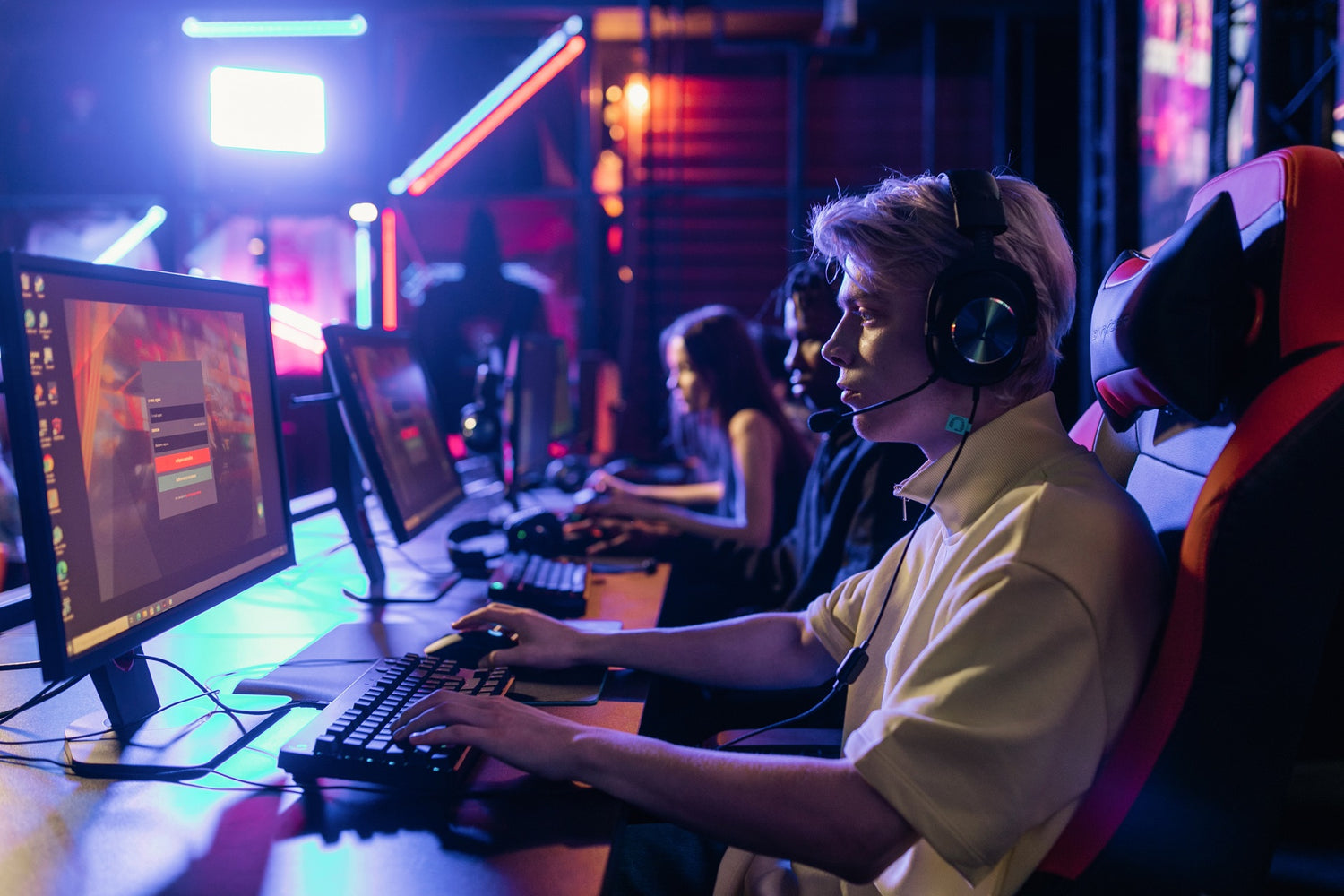
Choosing the Right Gaming Monitor: A Guide for Every Gamer
JayceSmith
Gaming monitors are the unsung heroes of immersive gaming experiences. Whether you're a casual gamer, a competitive eSports enthusiast, or an avid RPG explorer, the monitor you choose can significantly impact your gameplay. In this guide, we'll help you navigate the world of gaming monitors and make an informed decision that suits your gaming style.
**1. Panel Technology: TN, IPS, or OLED?**
The first consideration when choosing a gaming monitor is panel technology. Each has its pros and cons:
- **TN (Twisted Nematic)** panels are known for their fast response times and affordability. They're great for competitive gaming but may compromise on color accuracy and viewing angles.
- **IPS (In-Plane Switching)** panels offer better color accuracy and wider viewing angles. They're suitable for immersive gaming experiences with rich visuals but might have slightly slower response times.
- **OLED (Organic Light Emitting Diode)** panels are relatively new and provide exceptional contrast ratios and true blacks. They deliver vibrant colors and fast response times, making them ideal for gaming, but they can be costly.
**2. Resolution: HD, Full HD, 4K, or Ultrawide?**
Resolution determines the level of detail in your games:
- **HD (1280x720)**: Suitable for budget-friendly setups but may lack detail in modern games.
- **Full HD (1920x1080)**: A balance between cost and visual quality, providing crisp visuals for most gamers.
- **4K (3840x2160)**: Offers breathtaking detail but demands powerful hardware to run smoothly.
- **Ultrawide**: Provides an immersive gaming experience with a wider field of view but may require a beefy graphics card.
**3. Refresh Rate and Response Time: Smooth Gameplay**
Higher refresh rates (measured in Hertz, Hz) and faster response times (measured in milliseconds, ms) result in smoother gameplay. Aim for at least a 60Hz refresh rate and a response time of 5ms or less for a great gaming experience. Competitive gamers might prefer 144Hz or even 240Hz monitors.
**4. Adaptive Sync Technologies: G-SYNC vs. FreeSync**
Both NVIDIA's G-SYNC and AMD's FreeSync technologies eliminate screen tearing and stuttering by synchronizing the monitor's refresh rate with the graphics card's frame rate. Ensure your monitor supports the technology corresponding to your GPU.
**5. HDR and Color Accuracy: Vibrant Visuals**
High Dynamic Range (HDR) enhances contrast and color accuracy, resulting in more vibrant and lifelike visuals. Look for monitors with HDR support for a better gaming experience.
**6. Budget Considerations**
Gaming monitors come in various price ranges. Set a budget based on your gaming priorities and stick to it. Remember that investing in a quality monitor is a long-term investment in your gaming enjoyment.
**7. Size and Ergonomics: Finding the Right Fit**
Consider the physical size of the monitor and its adjustability. A larger screen can provide a more immersive experience, but it also requires more desk space. Adjustable stands allow you to customize the monitor's height, tilt, and rotation for comfortable gaming sessions.
**8. Connectivity: Ports and Compatibility**
Ensure the monitor has the necessary ports for your gaming setup, including HDMI, DisplayPort, and USB ports. Check compatibility with your gaming console or PC.
**9. Reviews and Recommendations**
Before making a final decision, read reviews and seek recommendations from fellow gamers. Real-world experiences can help you identify any potential issues or advantages with a particular monitor model.
Choosing the right gaming monitor is a crucial step in enhancing your gaming experience. Whether you're diving into a virtual world, competing in eSports tournaments, or enjoying a leisurely gaming session, a well-chosen monitor can make all the difference. So, do your research, consider your gaming preferences, and select the monitor that suits you best. Happy gaming!
**1. Panel Technology: TN, IPS, or OLED?**
The first consideration when choosing a gaming monitor is panel technology. Each has its pros and cons:
- **TN (Twisted Nematic)** panels are known for their fast response times and affordability. They're great for competitive gaming but may compromise on color accuracy and viewing angles.
- **IPS (In-Plane Switching)** panels offer better color accuracy and wider viewing angles. They're suitable for immersive gaming experiences with rich visuals but might have slightly slower response times.
- **OLED (Organic Light Emitting Diode)** panels are relatively new and provide exceptional contrast ratios and true blacks. They deliver vibrant colors and fast response times, making them ideal for gaming, but they can be costly.
**2. Resolution: HD, Full HD, 4K, or Ultrawide?**
Resolution determines the level of detail in your games:
- **HD (1280x720)**: Suitable for budget-friendly setups but may lack detail in modern games.
- **Full HD (1920x1080)**: A balance between cost and visual quality, providing crisp visuals for most gamers.
- **4K (3840x2160)**: Offers breathtaking detail but demands powerful hardware to run smoothly.
- **Ultrawide**: Provides an immersive gaming experience with a wider field of view but may require a beefy graphics card.
**3. Refresh Rate and Response Time: Smooth Gameplay**
Higher refresh rates (measured in Hertz, Hz) and faster response times (measured in milliseconds, ms) result in smoother gameplay. Aim for at least a 60Hz refresh rate and a response time of 5ms or less for a great gaming experience. Competitive gamers might prefer 144Hz or even 240Hz monitors.
**4. Adaptive Sync Technologies: G-SYNC vs. FreeSync**
Both NVIDIA's G-SYNC and AMD's FreeSync technologies eliminate screen tearing and stuttering by synchronizing the monitor's refresh rate with the graphics card's frame rate. Ensure your monitor supports the technology corresponding to your GPU.
**5. HDR and Color Accuracy: Vibrant Visuals**
High Dynamic Range (HDR) enhances contrast and color accuracy, resulting in more vibrant and lifelike visuals. Look for monitors with HDR support for a better gaming experience.
**6. Budget Considerations**
Gaming monitors come in various price ranges. Set a budget based on your gaming priorities and stick to it. Remember that investing in a quality monitor is a long-term investment in your gaming enjoyment.
**7. Size and Ergonomics: Finding the Right Fit**
Consider the physical size of the monitor and its adjustability. A larger screen can provide a more immersive experience, but it also requires more desk space. Adjustable stands allow you to customize the monitor's height, tilt, and rotation for comfortable gaming sessions.
**8. Connectivity: Ports and Compatibility**
Ensure the monitor has the necessary ports for your gaming setup, including HDMI, DisplayPort, and USB ports. Check compatibility with your gaming console or PC.
**9. Reviews and Recommendations**
Before making a final decision, read reviews and seek recommendations from fellow gamers. Real-world experiences can help you identify any potential issues or advantages with a particular monitor model.
Choosing the right gaming monitor is a crucial step in enhancing your gaming experience. Whether you're diving into a virtual world, competing in eSports tournaments, or enjoying a leisurely gaming session, a well-chosen monitor can make all the difference. So, do your research, consider your gaming preferences, and select the monitor that suits you best. Happy gaming!

